Snapshot
Although we believe that the prospects for the economy remain mostly unchanged, the outlook is softer at the margins, perhaps reflecting the tightening of financial conditions seen during the recent months. Over the past month, however, financial conditions have eased considerably on the assumption of impending rate cuts. This appears to be a familiar scenario of the markets quickly extrapolating slowing data and softening inflation into impending rate cuts, only to find rate cut expectations pushed back out again on the resulting easing of financial conditions.
Some rate cuts could occur in the months ahead as inflation rates decline significantly from their peaks and lift real rates. Interest rates may not need to be so high, and strongly inverted curves are not exactly helpful for the distortions they create in the financial markets. However, we believe that the current pricing in anticipation of rate cuts has gone well beyond any sensible adjustments as inflation is still a continued key risk in the eyes of central banks.
While we expect inflation to continue falling, we see the decline being a bumpy one with rates unlikely to get to central bank targets short of a recession. We are keeping a close eye on global demand, which in some cases is improving, such as with the technology (tech) hardware cycle; furthermore, significant investment in artificial intelligence (AI) is continuing, and Japan’s reflationary reform seems to be working. Hence, we still like the secular growth themes, which, coupled with inflation protection (commodity equities and gold), make good sense on top of a broadly diversified basket of attractive, high-quality yield.
Cross-asset1
We maintained our neutral growth score and a slightly overweight defensive score. Just as the US Federal Reserve (Fed) appeared satisfied with tightening to date, conditions eased again with yields compressing and risk assets finding healthy bids. While there are some expectations that the recent bout of tightening will deliver a deep blow to the economy, there is little to suggest that it could, in our view. The US economy continues to grind along on the back of accommodative fiscal policy, still healthy private sector balance sheets and a decent labour market.
After the recent bond market rally, duration is arguably expensive again—unless one believes that the economy is on the cusp of a recession that will require the Fed to cut rates in the not-too-distant future. This is not our view, and therefore we are quite happy taking the more attractive yield and spread offered at the shorter end of the curve.
Within growth, we again made no changes—still favouring secular growth in the form of Japan and US tech while also holding energy steady for its strong earnings and natural resilience to rising rates and inflation risks. Within defensive assets, we made a sizable shift from sovereigns to investment-grade (IG) credit; we also reduced the underweight to high-yield (HY) credit. Duration still makes sense, in our view, for its protective characteristics with respect to growth assets while we choose selectively.
Asset Class Hierarchy (Team View2)
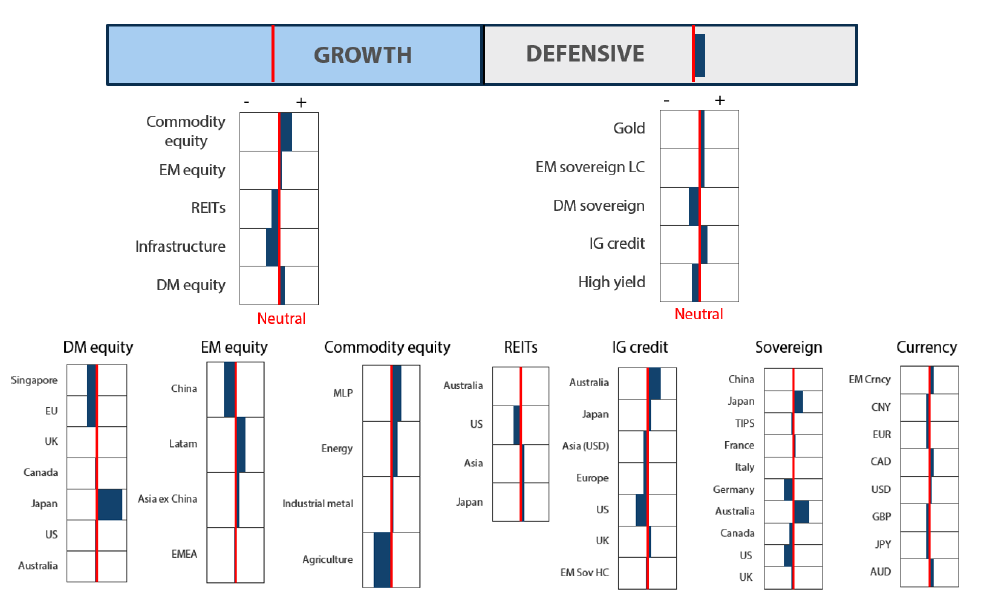
Research views
Growth assets
Despite a volatile journey, growth assets have generally performed well year to date (YTD)—posting double-digit gains—which were more broadly afforded by the strong relief rally in November. Visibility has improved as economies have held up generally better than expected, while peak rates appear to be behind us. Very importantly, profit margins held up much better than expected for the year, and there is little to suggest that they cannot hold up in 2024 amid the soft landing that we expect.
European equities finally broke to the upside, returning 20% YTD, after moving sideways following its 15% return in just the first four months of 2023. Europe entered recession while manufacturing and exports slowed on a disappointing recovery in China. The European Central Bank (ECB) appears to be in a good position to ease rates as inflation is down, and German purchasing managers' indices (PMIs) look to have bottomed.
Generally, we favour secular growth opportunities given that short-term credit offers a safe and attractive yield compared to the vulnerable earnings yield of equities. However, we remain opportunistic towards cyclical opportunities given that some regions, including Europe, could be heading towards an easing cycle. For now, forward earnings look less attractive for European equities though they could contain future opportunity yet to be seen by analysts.
The key question for Europe is whether external demand (mainly from China) improves, and how quickly the economy can recover given easier inflation and potentially lower rates ahead. Usually, rate cuts precede an economic bottom that sows the seeds of price and earnings recovery. The rally by equities seems too early in the conventional sense but, as we have noted frequently over recent years, conventional wisdom is not always the best guide in the current economic cycle.
Equities: the volatile road higher
Considering that equities were often tightly correlated to the worst of the bond market downside during the turmoil across the rates markets seen over the last few years, it is important to take a step back and assess what drove the development to appreciate the opportunities that might be ahead. In Chart 1 below, the cumulative performance over three years is remarkably close across equities in US tech (NASDAQ: +31%), Japan (TOPIX: +31%) and Europe (Euro Stoxx 50: +29%). Each market is up a very respectable ~9%, annualised, though the journey for each was quite volatile and remarkably different.
Chart 1: 3-year cumulative performance of NASDAQ, TOPIX and Euro Stoxx 50
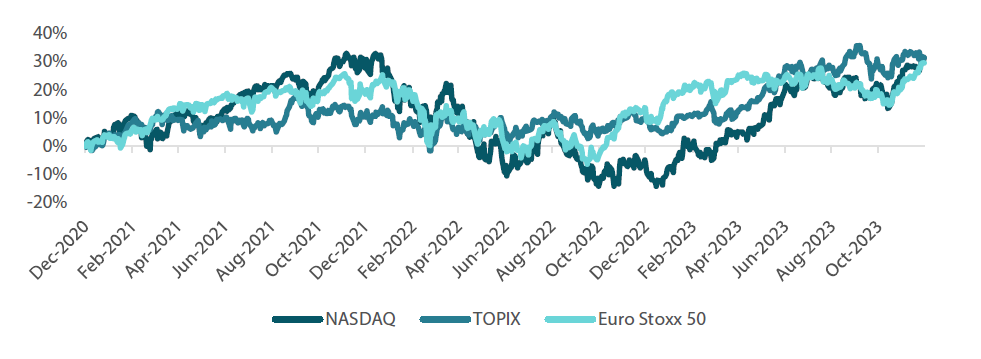
Source: Bloomberg, December 2023
Japan was the least volatile of the three—call it low beta—but there was a clear break to the upside in 2Q23 and it remains our top pick among equity markets for the structural reforms taking place in the country. NASDAQ bottomed at a cumulative -14% from late 2020 into early January 2023, driven by higher rates and a dip in earnings, but it roared back on AI hopes and significant upside surprise on real earnings. We liked Europe into early 2Q23, but disappointing China demand followed by a recession dimmed growth prospects that mainly played out as expected in the lacklustre performances of its equity markets. However, the Euro Stoxx 50 jumped as much as the NASDAQ did in November 2023.
Stocks ultimately follow earnings, and while forward earnings did decline for the NASDAQ during the second half of 2022 into early 2023, they aggressively lifted to new highs; all three markets have seen strong earnings growth from late 2020 (Chart 2). Revenues generally follow nominal GDP, and margins improved across the board, lifting forward earnings estimates over the period.
Chart 2: 3-year cumulative earnings growth (forward 12-month estimates)
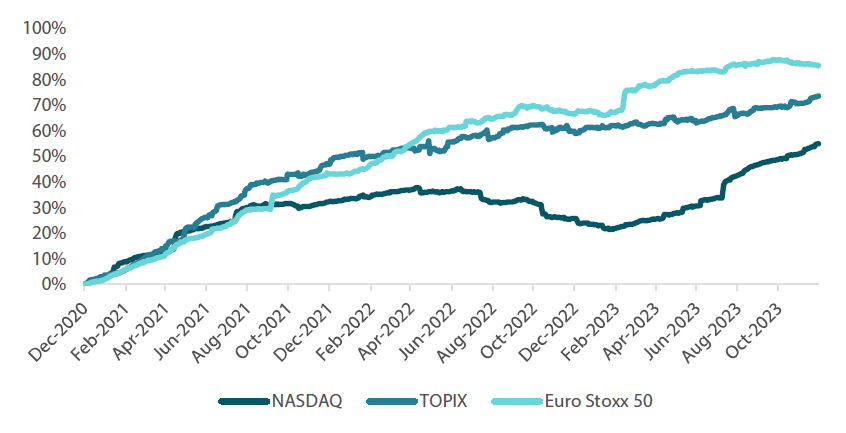
Source: Bloomberg, December 2023
Of these three markets, Europe is perhaps the most surprising, grinding out the highest forward earnings despite a domestic recession and weaker-than-hoped China demand that is important for European exports. However, it is worth noting that Europe’s forward expected earnings have been in decline from mid-October in contrast to its US and Japanese counterparts.
Valuations based on forward price-to-earnings look generally accurate, in our view, given the moves in price versus earnings (Chart 3). European equities look the “cheapest” at 12.5. Japan is 14.3, and the NASDAQ sits at 24.0, after peaking at 26.6 in late July 2023. Taking the inverse, this translates into earnings yields of about 8%, 7% and 4%, respectively. Of course, forward earnings yields matter, but their vulnerabilities to downside or potential upside vary quite considerably.
Chart 3: 3-year forward price to earnings (12-month earnings estimates)
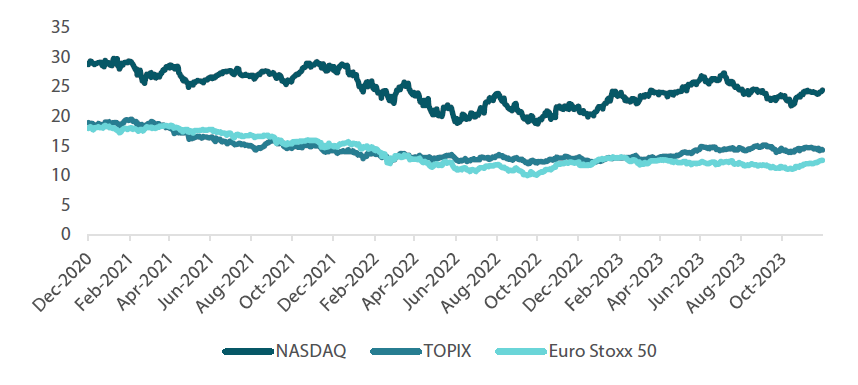
Source: Bloomberg, December 2023
Japan equities look more on the expensive side as price has moved faster than forward earnings. This may be seen as a reason for the more muted upside of Japan equities in November compared to the NASDAQ or the Euro Stoxx 50. But in our view, it more likely explains why Japan equities held up well during the July-October sell-off compared to their two peers. While Japan earnings have yet to see significant upgrades over the near term, they are solid and we believe the bigger story is in the country’s structural reforms. Japan earnings are therefore likely to point to much stronger profitability in the years ahead.
NASDAQ’s forward 12-month earnings are up 25% from the beginning of 2023, less than the 49% gains in price, but in this case, we believe secular growth driven by AI will be a key driver of earnings growth for years to come. Estimating the growth is inherently very speculative, but a recent academic study using patent data to project productivity enhancement suggests that up to 7% of existing jobs in some economies are vulnerable to automation where AI is a key ingredient. This is a big number and while there is a wide margin of error, real earnings growth is likely already here in the tech industry, which we expect will remain well-supported for years to come.
Europe is attractive from a valuation perspective. Driven by nominal GDP growth, earnings have surprised to the upside. So the key question is whether earnings can hold up as growth disappoints and inflation comes down. Europe may face rate cuts sooner than other regions. But the rate cuts are yet to be actually implemented and earnings are beginning to experience downgrades and will likely take time to recover. In any case, valuations may lend support and more upsides could be ahead, but for now we still see better long-term opportunities elsewhere.
Conviction views on growth assets
- Secular growth over cyclical yield: We continue to value structural and secular growth including Japan equities and US tech stocks that are still the best representation of beneficiaries of current and future earnings in the coming AI revolution.
- Commodity-linked equities: Commodity-linked equities offer attractive valuations and strong cash flow support that will remain durable in a soft landing and offer protection from still lingering inflation and rates risks.
- Selective emerging markets: Latin America is very inexpensive, showing a forward price-to-earnings of 8.0. The market is actually slightly down in local currency terms over three years, while earnings are up 55% over the same period. Earnings are finding recent upgrades, and long-term growth prospects are strong for their commodity exports, improving domestic demand, the ability to cut rates (real rates are the highest in the world) and “friend shoring” opportunities. Taiwan and South Korea are seen benefiting from the tech hardware upcycle. India may benefit from their strong earnings, new opportunities in “friend shoring” and the opening of new trade routes to the Middle East.
Defensive assets
We downgraded our view on sovereign bonds again to remain underweight within our defensive asset classes. While markets have been quick to apply the decades-old playbook of moving to price an easing of monetary policy that begins shortly after central banks have reached their terminal rates, the aftermath of the pandemic has clouded the economic outlook. Tighter monetary policy has had the desired effect in some areas such as Europe and the UK, but in the world's largest economy, the US, growth has so far been resistant to rate hikes. The inversion of most developed market yield curves has also made longer-term bonds less attractive. As a result, we prefer high grade credit over sovereign bonds.
We upgraded our view on IG credit again this month to be more overweight. The asset class has retained reasonable valuations and momentum is strong. We see this sector as the best place to look for yield in the defensive bucket, as high-grade issuers have strong balance sheets, and the sector offers above-average levels of spread. In addition, US growth has been more resilient than we previously thought, and in this environment where yields remain high, we expect IG credit to perform well.
UK’s convergence to Europe
Over the past three months, financial markets have begun forecasting relatively aggressive cash rate cuts in the eurozone, with cash rate expectations in one year’s time falling from 3.60% to 2.77%. While we have long suspected that the ECB would likely be one of the first central banks to cut interest rates, as their growth is entering recessionary levels and inflation has fallen to only 2.4%, there are signs forming that the UK may not be too far behind. Throughout 2023, the market’s expectations for the UK cash rate were the most hawkish in the developed world, exceeding 6.50% in the middle of the year. However more recently this hawkish view has been reversed, as the market now expects rate cuts to occur in around six months’ time.
Chart 4: UK cash rate expectations
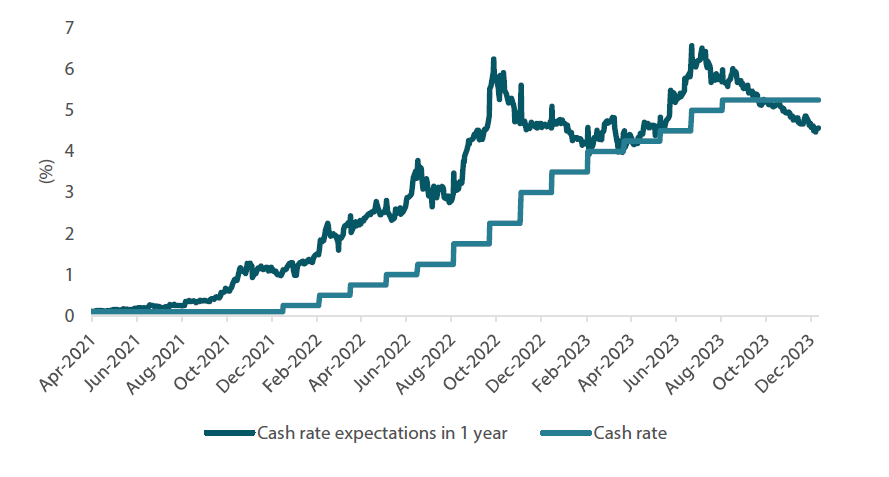
Source: Bloomberg, December 2023
The driver behind these changing fortunes stem from a run of poor economic data, which points to the Bank of England’s (BOE) hawkish demeanour coming to an end. From a growth perspective, the UK has registered only 0.5% of GDP growth through the first three quarters of 2023, with soft PMI surveys suggesting that more sluggish growth is yet to come. More importantly, however, is the trajectory that inflation has been on, rising at one of the fastest paces in the developed world before making a decent drop to more acceptable levels. Interestingly, as Chart 5 below shows, UK’s inflation appears to be on the exact same trajectory as the eurozone’s. This implies that the economy could be in store for more appropriate levels of inflation in the next three months.
Chart 5: UK and eurozone CPI
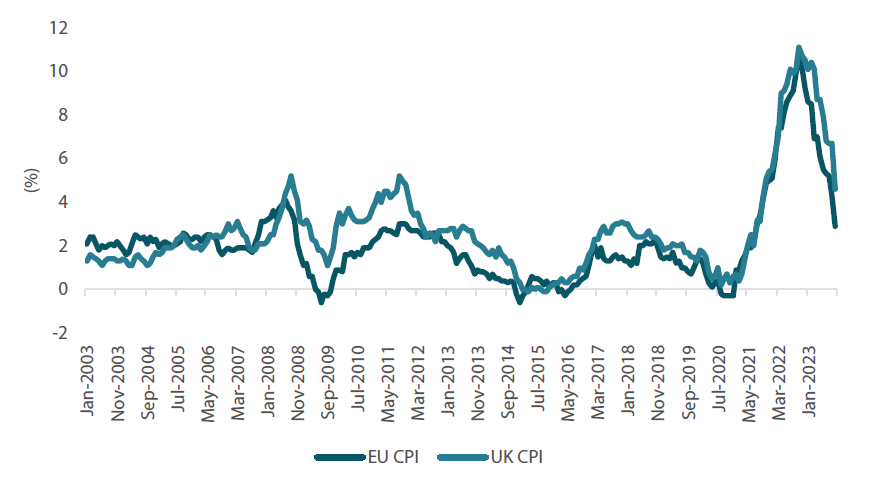
Source: Bloomberg, December 2023
Should inflation slow towards more normal levels, and growth remain at a sluggish pace, it would be increasingly hard for the BOE to argue that interest rates need to remain in a highly restrictive stance. Accordingly, while we have thought for some time that the ECB would need to cut rates, it is now becoming clearer that the UK will likely be on the exact same path, as conditions look similar across the European countries. From an interest rate perspective, this creates the potential for UK rates to continue their rally, as 10-year yields sit at almost 30-year highs relative to those of German Bunds (Chart 6). The BOE will potentially be a few months behind the ECB as inflation still has some ways to fall; however, the greater distance that yields could drop makes the UK a more interesting location to take duration positions.
Chart 6: UK 10-year rates – German 10-year rates
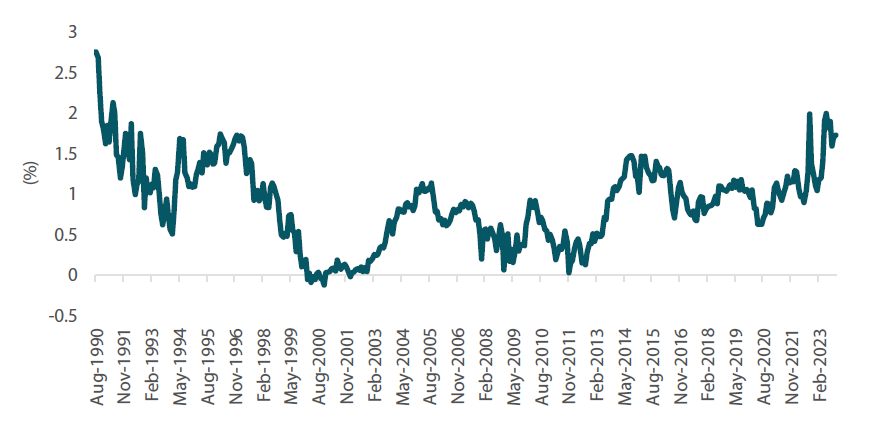
Source: Bloomberg, December 2023
Conviction views on defensive assets
- Short-dated IG credit: Credit spreads remain at fair levels but inverse yield curves in many markets make longer-dated credit less attractive, leaving shorter-dated credit as our preference.
- Gold is still an attractive hedge: Gold has been resilient in the face of rising real yields and a strong dollar while proving to be an effective hedge against geopolitical risks and sticky inflation pressures.
- Attractive yields in EM: Real yields in this sector are generally very attractive and we prefer quality EM currencies against the backdrop of a generally weaker dollar.
Process
In-house research to understand the key drivers of return:
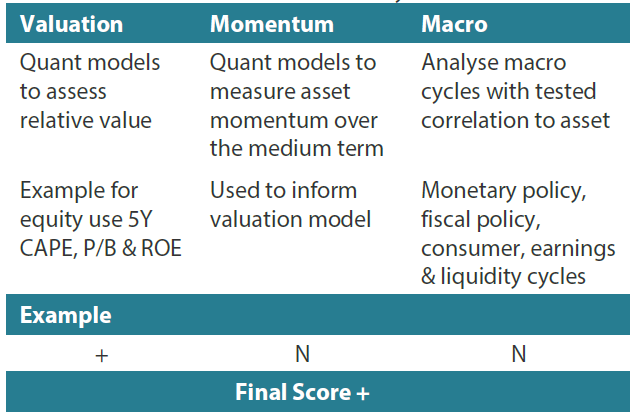
1The Multi Asset team’s cross-asset views are expressed at three different levels: (1) growth versus defensive, (2) cross asset within growth and defensive assets, and (3) relative asset views within each asset class. These levels describe our research and intuition that asset classes behave similarly or disparately in predictable ways, such that cross-asset scoring makes sense and ultimately leads to more deliberate and robust portfolio construction.
2The asset classes or sectors mentioned herein are a reflection of the portfolio manager’s current view of the investment strategies taken on behalf of the portfolio managed. The research framework is divided into 3 levels of analysis. The scores presented reflect the team’s view of each asset relative to others in its asset class. Scores within each asset class will average to neutral, with the exception of Commodity. These comments should not be constituted as an investment research or recommendation advice. Any prediction, projection or forecast on sectors, the economy and/or the market trends is not necessarily indicative of their future state or likely performances.



